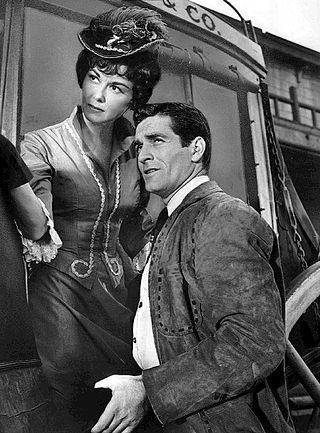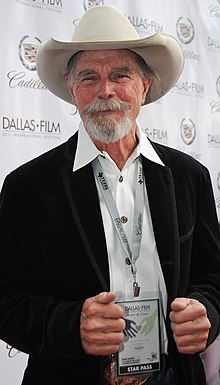Gunsmoke is an American radio and television Western drama series created by director Norman Macdonnell and writer John Meston. It centered on Dodge City, Kansas, in the 1870s, during the settlement of the American West. The central character is lawman Marshal Matt Dillon, played by William Conrad on radio and James Arness on television.

William Dennis Weaver was an American actor and president of the Screen Actors Guild, best known for his work in television and films from the early 1950s until just before his death in 2006. Weaver's two most famous roles were as Marshal Matt Dillon's trusty partner Chester Goode/Proudfoot on the western Gunsmoke and as Deputy Marshal Sam McCloud on the police drama McCloud. He starred in the 1971 television film Duel, the first film of director Steven Spielberg. He is also remembered for his role as the twitchy motel attendant in Orson Welles's film Touch of Evil (1958).

Bat Masterson is an American Western television series which was a fictionalized account of the life of real-life marshal, gambler, and journalist Bat Masterson. The title character was played by Gene Barry, and the half-hour black-and-white series ran on NBC from 1958 to 1961. The show was produced by Ziv Television Productions. "Bat" is a nickname for Masterson's first name, Bartholemew, although in both the 1958 pilot "Double Showdown" and 1961 episode "No Amnesty For Death", he says his name is William Barkley Masterson.

Ken Curtis was an American actor and singer best known for his role as Festus Haggen on the western television series Gunsmoke. He appeared on Gunsmoke earlier in other roles. His first appearance as Festus was in season 8, episode 13, "Us Haggens", which debuted December 8, 1962. His next appearance was Season 9, episode 2, October 5, 1963, as Kyle Kelly, in "Lover Boy". Curtis joined the cast of Gunsmoke permanently as Festus in "Prairie Wolfer", season 9 episode 16, which debuted January 18, 1964. This episode features the same title as a 1969 episode (S13E10).

James Arness was an American actor, best known for portraying Marshal Matt Dillon for 20 years in the series Gunsmoke. He has the distinction of having played the role of Dillon in five decades: 1955 to 1975 in the weekly series, then in Gunsmoke: Return to Dodge (1987) and four more made-for-television Gunsmoke films in the 1990s. In Europe, Arness reached cult status for his role as Zeb Macahan in the Western series How the West Was Won. He was the older brother of actor Peter Graves.

The Life and Legend of Wyatt Earp is the first Western television series written for adults. It premiered four days before Gunsmoke on September 6, 1955. Two weeks later came the Clint Walker western Cheyenne. The series is loosely based on the life of frontier marshal Wyatt Earp. The half-hour, black-and-white program aired for six seasons on ABC from 1955 to 1961, with Hugh O'Brian in the title role.
Gunsmoke is an American Western television series developed by Charles Marquis Warren and based on the radio program of the same name. The series ran for 20 seasons, making it the longest-running Western in television history.
Gunsmoke is an American Western television series developed by Charles Marquis Warren and based on the radio program of the same name. The series ran for 20 seasons, making it the longest-running Western in television history.
Gunsmoke is an American Western television series developed by Charles Marquis Warren and based on the radio program of the same name. The series ran for 20 seasons, making it the longest-running Western in television history.
Gunsmoke is an American Western television series developed by Charles Marquis Warren and based on the radio program of the same name. The series ran for 20 seasons, making it the longest-running Western in television history.
Gunsmoke is an American Western television series developed by Charles Marquis Warren and based on the radio program of the same name. The series ran for 20 seasons, making it the longest-running Western in television history.
Gunsmoke is an American Western television series developed by Charles Marquis Warren and based on the radio program of the same name. The series ran for 20 seasons, making it the longest-running Western in television history.
Gunsmoke is an American Western television series developed by Charles Marquis Warren and based on the radio program of the same name. The series ran for 20 seasons, making it the longest-running Western in television history.
Gunsmoke is an American Western television series developed by Charles Marquis Warren and based on the radio program of the same name. The series ran for 20 seasons, making it the longest-running Western in television history.
Gunsmoke is an American Western television series developed by Charles Marquis Warren and based on the radio program of the same name. The series ran for 20 seasons, making it the longest-running Western in television history.
Gunsmoke is an American Western television series developed by Charles Marquis Warren and based on the radio program of the same name. The series ran for 20 seasons, making it the longest-running Western in television history.
Gunsmoke is an American Western television series developed by Charles Marquis Warren and based on the radio program of the same name. The series ran for 20 seasons, making it the longest-running Western in television history.
Gunsmoke is an American Western television series developed by Charles Marquis Warren and based on the radio program of the same name. The series ran for 20 seasons, making it the longest-running Western in television history.
Roger Lawrence Ewing is an American film and television actor. He is perhaps best known for playing Clayton Thaddeus Greenwood in the American western television series Gunsmoke.





